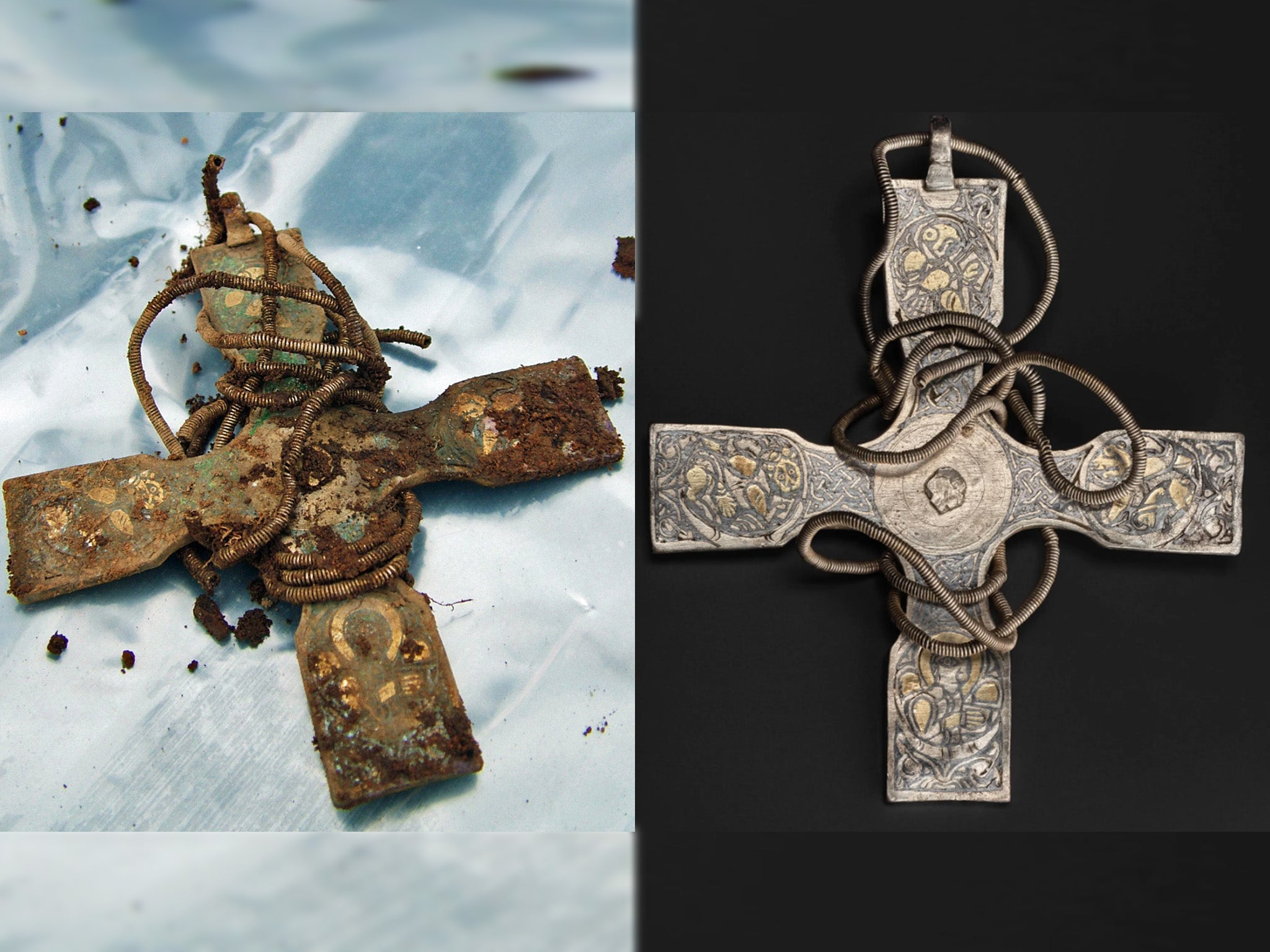1,000-year-old cross buried in Scottish field thought to have belonged to king
The silver cross was likely commissioned by those in the highest levels of Anglo-Saxon society

The true value of a 1,000-year-old Anglo-Saxon silver cross, found in Scotland in a rare hoard of Viking artefacts, has been revealed for the first time.
Delicate conservation work on the cross has unveiled its intricate decoration and it is now thought the individual who commissioned the treasure may have been a high-standing cleric or even a king.
Discovered by metal detectorist Derek McLennan when scanning a ploughed field in Dumfries and Galloway in 2014, the cross was dug up in the Galloway Hoard – the richest and rarest collection of Viking-era objects ever to be found in Britain and Ireland.
Conservators say the treasures are of international significance and could transform our understanding of this period of Scottish history. The collection was acquired by National Museums Scotland (NMS) in 2017.
Speaking to The Observer, Dr Martin Goldberg, NMS curator of early medieval and Viking collections, said: “It’s just spectacular. There really isn’t a parallel. That is partly because of the time period it comes from. We imagine that a lot of ecclesiastical treasures were robbed from monasteries – that’s what the historical record of the Viking age describes to us.
“This is one of the survivals. The quality of the workmanship is just incredible. It’s a real privilege to see this after 1,000 years.”
Unseen until now, the cross is adorned with intricate gold leaf decoration with its four arms bearing the symbols of four evangelists who wrote the gospels of the New Testament – Matthew (man), Mark (lion), Luke (cow) and John (eagle). It is believed the detailed decorations were created by a goldsmith of outstanding skill and artistry.
Dr Goldberg said: “This looks like the type of thing that would be commissioned at the highest levels of society. First sons were usually kings and lords, second sons would become high-ranking clerics. It’s likely to come from one of these aristocratic families.”
An intricate spiral chain was also found buried with the cross which suggests the treasure was almost certainly worn. “You could almost imagine someone taking it off their neck and wrapping the chain around it to bury it in the ground. It has that kind of personal touch,” Goldberg added.
The Galloway Hoard is thought to have been buried around AD900 and contains more than 100 diverse objects, from silver, gold and jewelled treasures to rarely surviving textiles that some of the objects were wrapped in, including wool, linen and Scotland’s earliest examples of silk.
A gold bird-shaped pin and a silver-gilt vessel were also unearthed.
It has taken years for conservators to chip away at the encrusted dirt on cross, using a carved porcupine quill sharp enough to pick away at the layers but not so hard as to cause damage.
The treasures are from a pivotal moment in Scottish history where new kingdoms were emerging in response to invasions from Vikings.
“Alfred the Great’s dynasty was laying the foundations of medieval England, and Alba, the kingdom that became medieval Scotland, is first mentioned in historical sources,” Dr Goldberg added.
Galloway was situated in the Anglo-Saxon Northumbria area, dubbed the Saxon coast in Irish chronicles from as late as the 10th century.
However, the area soon became known as the Lordship of Galloway, named by the Gall-Gaedil people who were of Scandinavian descent and spoke gaelic – they dominated the Irish Sea during the Viking age.
“The mixed material of the Galloway Hoard exemplifies this dynamic political and cultural environment,” Dr Goldberg said.
Dr Leslie Webster, former keeper of Britain, Prehistory and Europe at the British Museum, said: “It is a unique survival of high-status Anglo-Saxon ecclesiastical metalwork from a period when – in part, thanks to the Viking raids – so much has been lost.”
The Galloway Hoard: Viking-age Treasure exhibition will be at the National Museum of Scotland in Edinburgh from 19 February to 9 May before touring to Dundee and Aberdeen later on in the year.
Subscribe to Independent Premium to bookmark this article
Want to bookmark your favourite articles and stories to read or reference later? Start your Independent Premium subscription today.

Join our commenting forum
Join thought-provoking conversations, follow other Independent readers and see their replies